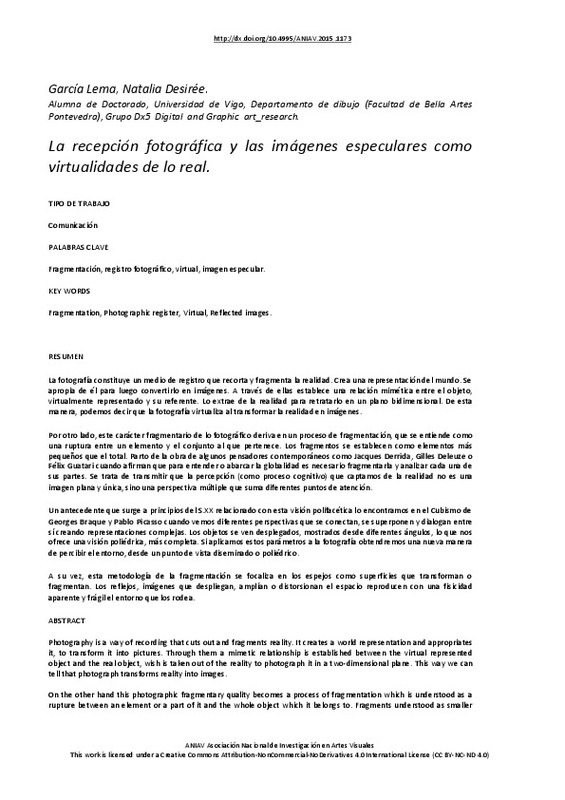JavaScript is disabled for your browser. Some features of this site may not work without it.
Buscar en RiuNet
Listar
Mi cuenta
Estadísticas
Ayuda RiuNet
Admin. UPV
La recepción fotográfica y las imágenes especulares como virtualidades de lo real
Mostrar el registro sencillo del ítem
Ficheros en el ítem
| dc.contributor.author | García Lema, Natalia
|
es_ES |
| dc.date.accessioned | 2017-10-03T10:37:47Z | |
| dc.date.available | 2017-10-03T10:37:47Z | |
| dc.date.issued | 2015-11-26 | |
| dc.identifier.isbn | 9788490483411 | |
| dc.identifier.uri | http://hdl.handle.net/10251/88541 | |
| dc.description.abstract | [EN] Photography is a way of recording that cuts out and fragments reality. It creates a world representation and appropriates it, to transform it into pictures. Through them a mimetic relationship is established between the virtual represented object and the real object, wish is taken out of the reality to photograph it in a twoIdimensional plane. This way we can tell that photograph transforms reality into images. On the other hand this photographic fragmentary quality becomes a process of fragmentation which is understood as a rupture between an element or a part of it and the whole object which it belongs to. Fragments understood as smaller elements from the whole object. Starting from the works of some contemporary philosophers and great thinkers as: Jacques Derrida, Gilles Deleuze or Félix Guattari, who affirm that to understand or to embrace the whole object, it is necessary to fragment and analyse each part of the whole separately. It’s about transmitting the perception (as a process of cognition) that all we capture from the reality is not a flat and unique image but a manyIsided perspective where different attention points are summarized. A previous experiment related to the manyIsided vision is set at the beginning of the 20th Century in the Cubism by Georges Braque and Pablo Picasso, where we can see different perspectives, linked, superimposed and establishing a dialogue between them and at the same time, creating complex representations. Objects can be seen unfolded, shown from different points of view what offers us a perfect and complete polyhedral vision. If we apply all this to the photography we will get a new way of observing our surroundings from a spread or polyhedral points of view. At the same time, this methodology of fragmentation is focussed on mirrors because they are surfaces that transform or fragment reality. Reflections as images that unfold, enlarge or distort the space reproduce a physical and fragile appearance the surrounding environment. | es_ES |
| dc.description.abstract | [ES] La fotografía constituye un medio de registro que recorta y fragmenta la realidad. Crea una representación del mundo. Se apropia de él para luego convertirlo en imágenes. A través de ellas establece una relación mimética entre el objeto, virtualmente representado y su referente. Lo extrae de la realidad para retratarlo en un plano bidimensional. De esta manera, podemos decir que la fotografía virtualiza al transformar la realidad en imágenes. Por otro lado, este carácter fragmentario de lo fotográfico deriva en un proceso de fragmentación, que se entiende como una ruptura entre un elemento y el conjunto al que pertenece. Los fragmentos se establecen como elementos más pequeños que el total. Parto de la obra de algunos pensadores contemporáneos como Jacques Derrida, Gilles Deleuze o Félix Guatari cuando afirman que para entender o abarcar la globalidad es necesario fragmentarla y analizar cada una de sus partes. Se trata de transmitir que la percepción (como proceso cognitivo) que captamos de la realidad no es una imagen plana y única, sino una perspectiva múltiple que suma diferentes puntos de atención. Un antecedente que surge a principios del S.XX relacionado con esta visión polifacética lo encontramos en el Cubismo de Georges Braque y Pablo Picasso cuando vemos diferentes perspectivas que se conectan, se superponen y dialogan entre sí creando representaciones complejas. Los objetos se ven desplegados, mostrados desde diferentes ángulos, lo que nos ofrece una visión poliédrica, más completa. Si aplicamos estos parámetros a la fotografía obtendremos una nueva manera de percibir el entorno, desde un punto de vista diseminado o poliédrico. A su vez, esta metodología de la fragmentación se focaliza en los espejos como superficies que transforman o fragmentan. Los reflejos, imágenes que despliegan, amplian o distorsionan el espacio reproducen con una fisicidad aparente y frágil el entorno que los rodea | es_ES |
| dc.format.extent | 7 | es_ES |
| dc.language | Español | es_ES |
| dc.publisher | Editorial Universitat Politècnica de València | es_ES |
| dc.relation.ispartof | II CONGRESO INTERNACIONAL DE INVESTIGACIÓN EN ARTE VISUALES | es_ES |
| dc.rights | Reconocimiento - No comercial - Sin obra derivada (by-nc-nd) | es_ES |
| dc.subject | Arte | es_ES |
| dc.subject | Producción artística | es_ES |
| dc.subject | Estética | es_ES |
| dc.subject | Teoría del Arte | es_ES |
| dc.subject | Gestión cultural | es_ES |
| dc.subject | Educación artística | es_ES |
| dc.subject | Investigación artística | es_ES |
| dc.title | La recepción fotográfica y las imágenes especulares como virtualidades de lo real | es_ES |
| dc.type | Capítulo de libro | es_ES |
| dc.type | Comunicación en congreso | es_ES |
| dc.identifier.doi | 10.4995/ANIAV2015.1173 | |
| dc.rights.accessRights | Abierto | es_ES |
| dc.description.bibliographicCitation | García Lema, N. (2015). La recepción fotográfica y las imágenes especulares como virtualidades de lo real. En II CONGRESO INTERNACIONAL DE INVESTIGACIÓN EN ARTE VISUALES. Editorial Universitat Politècnica de València. 292-298. https://doi.org/10.4995/ANIAV2015.1173 | es_ES |
| dc.description.accrualMethod | OCS | es_ES |
| dc.relation.conferencename | II Congreso Internacional de Investigación en Artes Visuales. |< real | virtual >| ANIAV2015 | es_ES |
| dc.relation.conferencedate | July 09-10,2015 | es_ES |
| dc.relation.conferenceplace | Valencia, Spain | es_ES |
| dc.relation.publisherversion | http://ocs.editorial.upv.es/index.php/ANIAV/ANIAV2015/paper/view/1173 | es_ES |
| dc.description.upvformatpinicio | 292 | es_ES |
| dc.description.upvformatpfin | 298 | es_ES |
| dc.type.version | info:eu-repo/semantics/publishedVersion | es_ES |
| dc.relation.pasarela | OCS\1173 | es_ES |








